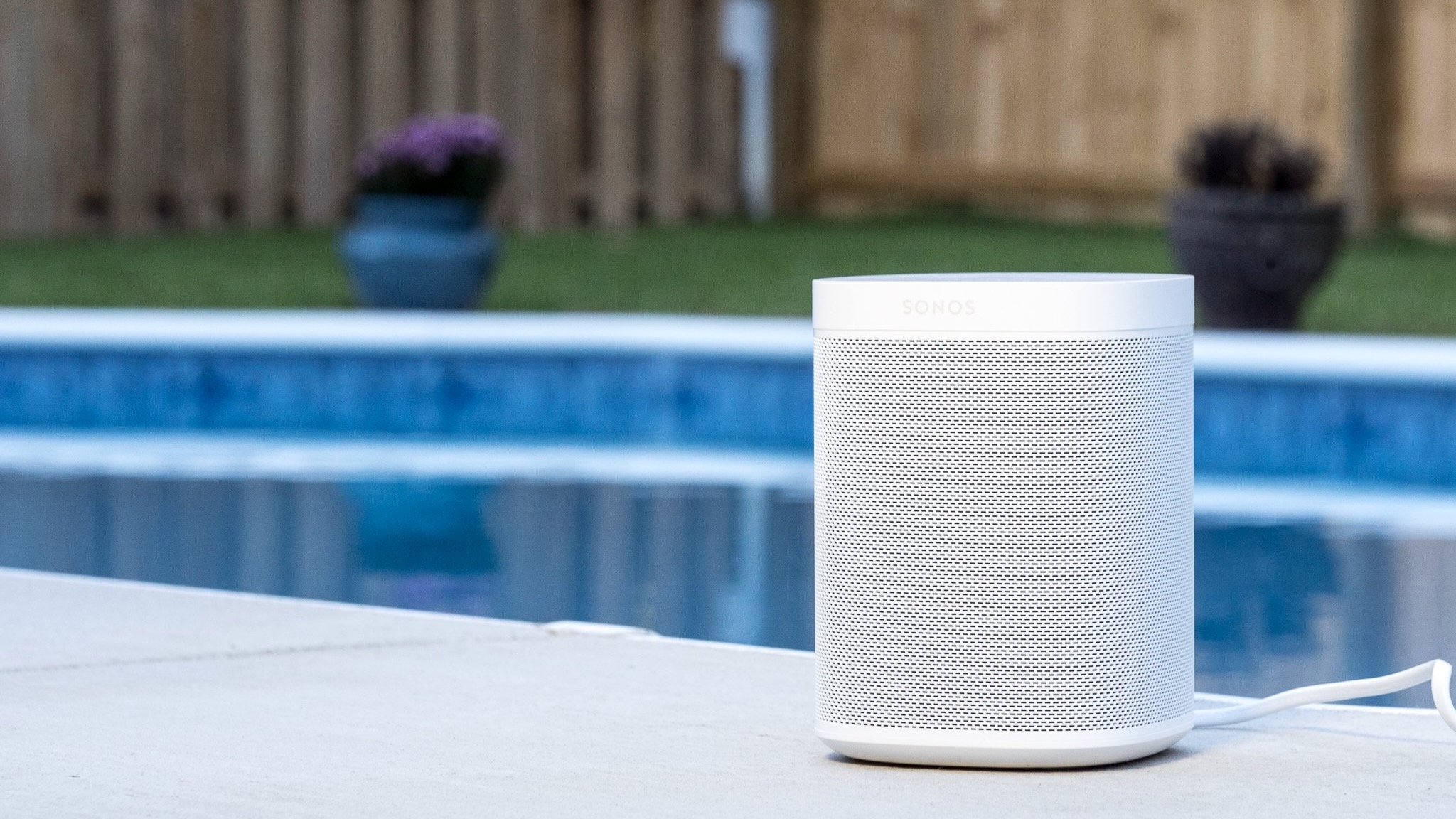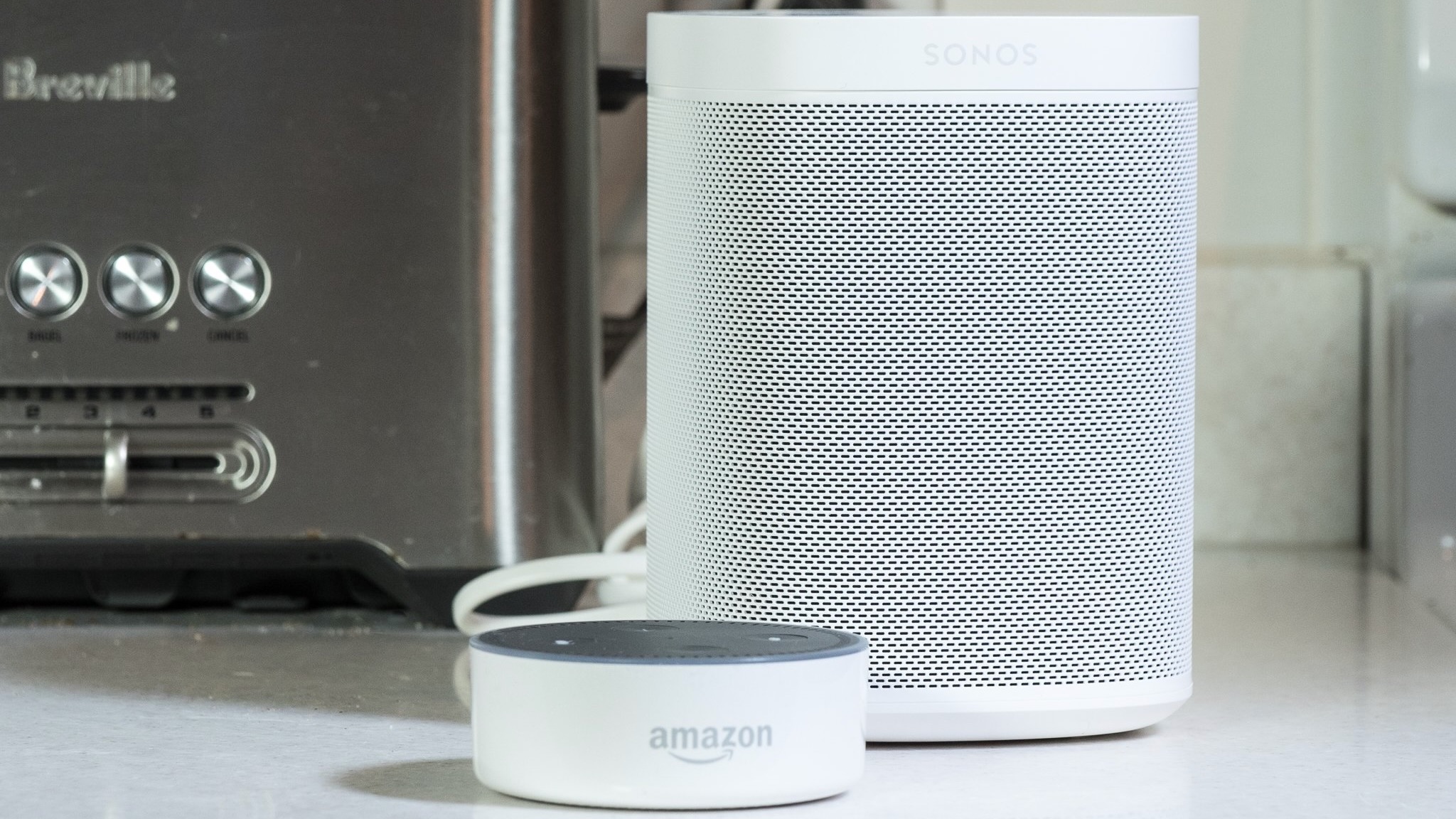Amazon Echo (4th Gen) vs. Sonos One: Which should you buy?
Which smart speaker has the right sound, voice assistant, or price for you?

All the Alexa upgrades
The latest generation of the Amazon Echo gives you a stylish sphere-shaped speaker with enhanced audio, new Zigbee smart home compatibility, and rapid-fire Alexa commands at half the price of Sonos' speaker.
For
- Faster Alexa commands
- Half the price of Sonos One
- Dual tweeters
- More color options & unique design
- Zigbee and Sidewalk smart hub
- Bluetooth support
Against
- No Ethernet port
- Only works with Alexa
- Relies on Bluetooth

Still sounds sweet
The Sonos One is built to handle either Alexa or Google Assistant commands and can connect to your iOS devices and Apple TV via AirPlay 2, but it's not a Bluetooth-compatible speaker. Despite its years-old design, its internal speakers make it sound just as great as ever.
For
- Still-excellent sound profile
- Google Assistant, AirPlay 2 support
- Ethernet port
- TruePlay calibration
- Multi-room Sonos audio
Against
- No Bluetooth support
- Twice the price of Echo
Both the Amazon Echo (4th Gen) and Sonos One are excellent smart speakers that came out several years ago but still hold their own against newer competition. So how do they compare to one another? Sonos gives you more versatility in choosing your smart home and assistant and offers fantastic audio quality, but the Amazon Echo costs much less and offers proper Bluetooth support. We'll help you decide which device fits your needs more.
Amazon Echo vs Sonos One: Specs and features

Without beating around the bush, we list the Sonos One and Echo (4th Gen) as the first and second-best smart speakers available today, beating out any other competition. That should tell you, at least, that you're not making a bad purchase whichever you choose. But stacked up against one another, these two smart speakers have very different traits.
| Header Cell - Column 0 | Amazon Echo (4th Gen) | Sonos One |
|---|---|---|
| List Price | $100 | $200 |
| Dimensions | 5.7" x 5.7" x 5.2", 2.14 lb | 4.69" x 4.69" x 6.36", 4.08 lb |
| Colors | Charcoal, Glacier White, Twilight Blue | White, Black |
| Processor | AZ1 Neural Edge | Unknown |
| Speakers | 3" woofer, dual front-firing 0.8" tweeters | Two Class-D digital amplifiers, one tweeter, one mid-woofer |
| Microphones | Six-microphone array | Six-microphone array |
| "Mic on" indicator | LED ring around the base | Single light on top |
| Bluetooth | A2DP, AVRCP, and BLE Mesh | No, only BLE for setup |
| Wi-Fi | 802.11a/b/g/n/ac (2.4 / 5 GHz) | 802.11 b/g, 2.4 GHz |
| Ethernet port | No | Yes |
| 3.5mm line in-out | Yes | No |
| Pair Multiple for Stereo Sound | Yes | Yes |
| Voice assistant support | Built-in Alexa | Built-in Google Assistant, built-in Alexa |
| Smart home tech | Zigbee smart home hub, Sidewalk Bridge | Can control Alexa or Google Assistant-compatible devices |
| Smart TV compatibility | Pairs with newest Fire TV devices for audio output | Pairs with Apple TV via AirPlay 2 |
| Dolby Processing | Yes | No |
| Room calibration | Yes, automatically adapts to room size | Yes (TruePlay, iOS only) |
Amazon Echo vs Sonos One: Sound quality showdown

The Sonos One was re-released in 2019 with an updated processor, memory, and connectivity, but its speakers remained untouched. Our original 2017 Sonos One review called the audio "really good considering the size and the price" and that it is "able to crank out a surprising amount of sound" that works for a small living room or kitchen space.
In other words, it still has an impressive volume and clarity of sound that hasn't been overtaken years later.
The Amazon Echo has twice the tweeters as the Sonos One for half the price.
That said, the Amazon Echo (4th Gen) has proven that you can squeeze more drivers into a smart speaker for quality sound without requiring a luxury price. The Amazon Echo has two dual-firing tweeters and a large woofer — compared to one tweeter, one woofer, and two digital amplifiers in the Sonos One — for half the price.
In our Echo (4th Gen) review, we praised the speaker's audio quality as well: "The Echo kicks out a ton of bass, but it never gets to the point where it sounds too muddy. You get a nice thump on the low end, but the mid and high end still sounds good to my ears."
That being said, our reviewer, who "used to rely on the Sonos One" as his office speaker, said that "it's impressive just how well the Echo holds up to it," though "Sonos still delivers audio that's more well-rounded."
Both speakers give you EQ controls for fixing the audio settings to fit the shape of the room or your own tastes. Sonos has a TruePlay app that uses the microphones in your iPhone to manually calibrate the room settings; unfortunately, Sonos has not made an Android TruePlay app, so you'll need to adjust the One EQ settings manually. Amazon has both iOS and Android apps for adjustments, and it promises to automatically adapt its EQ settings to the layout of your living room.
Amazon Echo vs Sonos One: Connectivity clash

Sonos works with more smart home ecosystems, giving you more flexibility if you want to switch. Specifically, it works with both Alexa and Google Assistant, though you must pick one to be your default listener. It also lets you stream content from your iOS devices to the One through AirPlay 2.
The Sonos One works with both Alexa and Google Assistant, but not both at the same time.
Sonos also has robust multi-room controls, so if you want to pair the Sonos One with other Sonos speakers like the Arc soundbar for your TV or Sonos Move in another room in the house, you can connect all of them via the Sonos S2 app.
The S2 app is the focal point of your One experience. You can easily add third-party music streaming apps to the S2 app so you can direct your speaker to stream music over 2.4GHz Wi-Fi without having to use Bluetooth.
That makes sense since the speaker doesn't support Bluetooth streaming at all. That makes it impossible, for example, for a friend to connect their phone to take over the party playlist. But outside of that scenario, you can stream music apps like Apple Music, Spotify, Amazon Music, Audible, Deezer, Pandora, TuneIn, iHeartRadio, and YouTube Music directly on the speaker.
The Sonos S2 app and AirPlay 2 support are convenient, if restrictive, alternatives to Bluetooth support.
With the Amazon Echo (4th Gen), you have a more traditional smart streaming experience. It has the latest Bluetooth and Wi-Fi protocols, so you can connect any iOS or Android app and stream content from it. It can easily pair with another Echo speaker for stereo sound, or you can connect another speaker or headphones to it with the rear 3.5mm jack (which the Sonos One lacks).
Both smart speakers can pair with specific TV brands to upgrade your TV audio. Fire TV owners can turn their Echos into surround sound speakers, while the Sonos One can connect to an Apple TV using AirPlay 2. It's safe to say that buying two Echos is more reasonable for your budget than two Sonos Ones, however.
Amazon Echo vs Sonos One: Voice assistants and smart home tech

If you want a smart speaker to use for Alexa commands, you'll want to choose the new Amazon Echo. Our Sonos One reviewer found that Echo devices picked up Alexa commands far better than the Sonos One. That was in 2017, and Amazon's subsequent Echo devices have only improved by then. Specifically, the speaker has a new processing chip that Amazon claims can respond to your Alexa commands twice as fast.
The Sonos One (2nd Gen) also got a processor update in 2019, but we suspect that Amazon's newest device is optimized for Alexa commands better than the Sonos One, which must also save memory for Google Assistant.
Zigbee compatibility, a Bridge-expanded smart home, and Guard Plus security features are all useful, exclusive Echo features.
Also, only Echo devices can use some of Amazon's exclusive smart home services like Amazon Sidewalk and Alexa Guard Plus. The latter service turns your Echo into a security hub that can alert your phone if a fire alarm goes off or emit a siren to scare off intruders if your Blink or Ring security cams detect an intruder.
Amazon also made the Echo a Zigbee hub, which allows you to control any Zigbee-compatible smart home tech like switches, thermostats, and smart locks using Alexa commands. Even with the Alexa app, the Sonos One can't do the same.
However, if you want to use Google Assistant or Siri, the Sonos One is the no-brainer choice. You can control your Sonos One through Siri commands and the Apple Home app — you'll just have to speak your commands into your iOS device, as the speaker's mics will ignore them.
Amazon Echo vs Sonos One: Which should you buy?

Die-hard Sonos speaker users aside, it's hard to justify the high cost of the Sonos One in 2020, with the latest Amazon Echo and the Nest Audio making big additions to their smart assistant features at a lower price.
You may prefer Sonos thanks to its S2 app serving as a one-stop library for all your music streaming platforms, so you don't need to worry about connecting your phone via Bluetooth. If you use iOS devices, AirPlay 2 is an effective alternative to Bluetooth, but Android users will likely miss having that Bluetooth option, and the Sonos One just doesn't pick up voice commands as effectively as an Echo.
Unless you have a specific device like a Sonos soundbar, iPhone, Apple TV, or Google Assistant-compatible tech that makes the Sonos One the better choice, we'd recommend the Echo as a more affordable choice.

A smart home and security hub
The Amazon Echo 4th Gen adds in a brainier Alexa and improved speaker tech that, while not quite as rich as the Sonos One's sound, certainly holds its own. It's one of the best smart speakers available today.

Best for Apple users
Google Assistant or Siri users who don't care for Alexa should look into the Sonos One. You get full support for Google voice commands, can stream virtually any music app through the Sonos app with an Ethernet port for consistent internet speeds, and get pristine, loud audio.
Be an expert in 5 minutes
Get the latest news from Android Central, your trusted companion in the world of Android

Michael is Android Central's resident expert on wearables and fitness. Before joining Android Central, he freelanced for years at Techradar, Wareable, Windows Central, and Digital Trends. Channeling his love of running, he established himself as an expert on fitness watches, testing and reviewing models from Garmin, Fitbit, Samsung, Apple, COROS, Polar, Amazfit, Suunto, and more.
